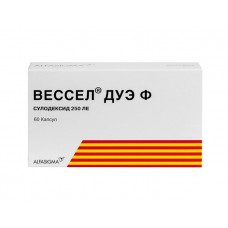Expiration date: 02/2029
The composition and form of issue:
Solution for injection. 1 vial contains:
the sulodexide 600 IU
auxiliary substances: sodium chloride 18 mg water for preparation of injections — q.s. up to 2 ml
in 2 ml ampoules in a box 10 ampoules.
Capsule. 1 capsule contains:
the sulodexide 250 LE
excipients: sodium lauryl — 3,3 mg of colloidal silicon dioxide and 3.0 mg of triglycerides — 86,1 mg
composition capsules: gelatin — 55,0 mg of glycerin — 21,0 mg of sodium ethyl-p-oxybenzoic — 0,24 mg of sodium propilparagidroksibenzoat — 0.12 mg titanium dioxide (E171) and 0.30 mg red ferric oxide — 0,90 mg
in blister, 25 PCs in a carton 2 blisters.
Description pharmaceutical form:
Solution for injection: light yellow or yellow transparent solution, placed in vials made of dark glass.
Capsules: soft gelatin capsules oval-shaped, brick-red color.
Feature:
A natural product isolated from the mucosa of the small intestine of the pig. Is a natural mixture of glycosaminoglycans: geparinoterapii fraction with a molecular weight of 8,000 daltons (80%) and dermatan sulfate (20%).
Pharmacokinetics:
90% is absorbed in the vascular endothelium (creates a concentration 20-30 times more than its concentration in the tissues of other organs) and absorbed in the small intestine. Metabolized in the liver and kidneys. Unlike unfractionated heparin and low molecular weight heparins, sulodexide is not subject to desulfation, which leads to a reduction of antithrombotic activity and speeds up the elimination from the body. Dose distribution in organs showed that the drug undergoes extracellular diffusion in the liver and kidney 4 h after injection.
24 h after I/V administration urinary excretion is 50% of the drug, and after 48 h was 67%.
Description pharmacological action:
Rapid geparinoida faction has affinity to antithrombin III and dermatology — heparin cofactor II. The anticoagulant effect is due to the affinity to heparin cofactor II that inactivates thrombin.
The antithrombotic mechanism of action is associated with inhibition of activated factor X, with the increased synthesis and secretion of prostacyclin (???2) with the decrease in the level of fibrinogen in blood plasma.
Profibrinolytic effect due to the increase in blood levels of tissue plasminogen activator and a decrease in the content of his inhibitor.
Angioprotektivnoe the action involves the restoration of structural and functional integrity of endothelial cells of blood vessels, with restoration of normal density negative electric charge then the basement membrane of blood vessels. In addition, the drug normalizes the flow properties of blood by reducing the level of triglycerides (stimulates lipolytic enzyme — known as lipoprotein lipase, hydrolysis of the triglycerides contained in the composition of LDL).
Reduces blood viscosity, inhibits cell proliferation mesange, reduces the thickness of the basal membrane.
Indications:
- angiopathy with increased risk of thrombotic events, including myocardial infarction
- cerebrovascular disease, including acute ischemic stroke and early recovery
- encephalopathy caused by atherosclerosis, diabetes, hypertension
- vascular dementia
- occlusive peripheral arterial atherosclerotic and diabetic origin
- of phlebopathy, deep venous thrombosis,
- microangiopathy (nephropathy, retinopathy, neuropathy) and macroangiopathy (diabetic foot syndrome, encephalopathy, cardiomyopathy) diabetes
- thrombophilic disorders, antiphospholipid syndrome (in conjunction with acetylsalicylic acid and followed by low molecular weight heparins)
- treatment of heparin-induced thrombotic thrombocytopenia (GTT), since the drug is not aggravated by GTT.
Contraindications:
- hypersensitivity
- hemorrhagic diathesis and diseases, accompanied by reduced blood clotting
- pregnancy (I trimester).
Application of pregnancy and breast-feeding:
When pregnancy appointed under the strict supervision of a physician. There is a positive experience for the treatment and prevention of vascular complications in patients with type 1 diabetes in II and III trimestrah pregnancy, the development of late toxemia of pregnancy — preeclampsia.
Side effects:
From the digestive tract: nausea, vomiting, epigastric pain.
Allergic reactions: rash.
Other: pain, burning, hematoma at the injection site.
Drug interactions:
Not recommended simultaneous use of drugs affecting hemostasis (direct and indirect anticoagulants, antiplatelet agents).
Method of application and dose:
In/m,/in (150-200 ml of saline) inside. At the beginning of treatment the contents of 1 ampoule to be administered daily I/m for 15-20 days, then 1 caps. 2 times a day by mouth between meals for 30-40 days. The full course should be repeated at least 2 times a year. At the discretion of the doctor mode may be changed.
Overdose:
Symptoms: bleeding or bleeding.
Treatment: cancel the drug, symptomatic therapy.
Special instructions:
If necessary, it is recommended to use the drug for the control of coagulation. At the beginning and end of the treatment it is useful to define the following parameters: APTT (normal is 30-40, depending on the type and concentration of activator used may be 25-30 or 35 to 50 C), the content of antithrombin III (normal — 210-300 mg/l), bleeding time (normal for Duque 2-4 min), clotting time unstabilized blood (the normal method of Miliana in the modification of morawica — 6-8 min). Vessel due f increases the normal levels approximately half.




